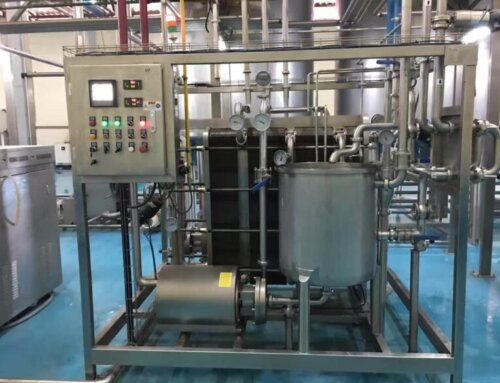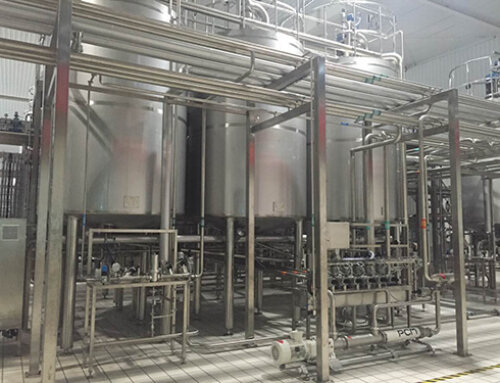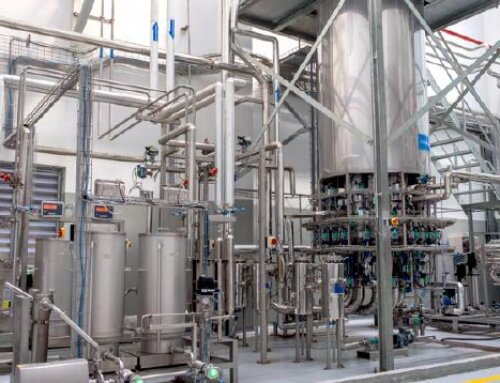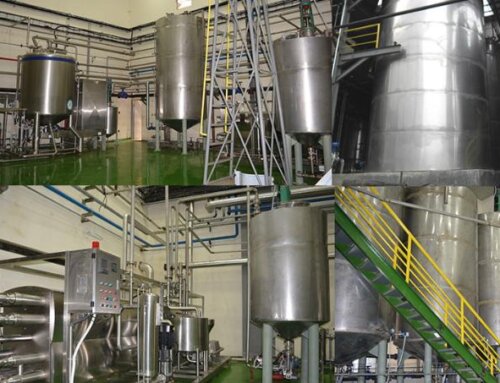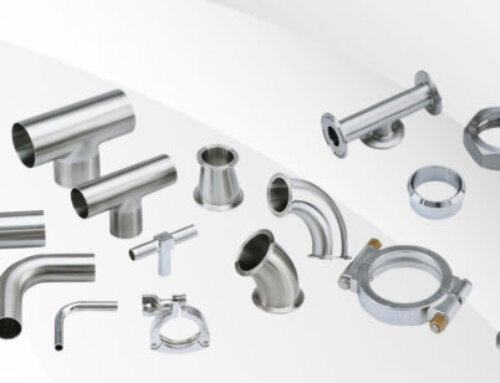Energy Drinks Production Line Description
- Energy beverages refer to beverages that are adapted to the nutritional needs of certain special populations by adjusting the composition and content ratio of natural nutrients in the beverages. They are suitable for specific populations to drink, have the function of regulating body functions, and are not aimed at curing diseases. The main function of functional drinks is to fight fatigue, replenish energy and boost the immune system.
- The energy drinks production line includes an ingredients mixing system, sugar dissolving system, functional drinks pasteurizing system, filling system and packing system, RO water treatment system and CIP cleaning system.
- The capacity for the energy drinks processing line is from 1000LPH-20000LPH and the end products can be filled into bottles or tin cans.
- All the machines are made of SUS304 food-grade material and it can ensure food safety and hygiene conditions.
- The most popular functional drinks are energy drinks, sports drinks, nutrient drinks, electrolyte drinks.
- We offer a turnkey project processing line for producing energy drinks, sports drinks and other functional drinks.
The Energy Drinks Production Ingredients
The energy drinks ingredients mainly include the following:
Functional sweeteners: mainly single candy sugars and polysaccharide alcohols (xylitol, sorbitol)
Functional oils: including fatty acids, phospholipids, choline and oil substitutes.
Vitamins: commonly used vitamin C, vitamin A and vitamin E
Peptides and proteins: glutathione (GSH), hypotensive peptides, calcium absorption peptides and immune Epidemic globulin, inhibit cholesterol protein, etc.
Active bacteria: These mainly include lactic acid bacteria, bifidobacteria and so on.
Mineral elements: functional ingredients mainly include calcium, iron, zinc, selenium, Chrome etc.
Other functional ingredients: octacosanol, flavonoids, saponins, phenols, phytosterols, allicin, taurine, L-carnitine, chlorogenic acid, etc.

Energy Drinks Production Flowchart
The sweeteners, sugar, sour agents and minerals will be dissolved with one water powder mixing tank, then filtered the impurity and transfer into blending tanks; Plant or herb extractions will also be added into the blending tank through pump; Vitamins, pigments also mixed in the blending tank. After all these ingredients mix evenly, then pasteurize and fill into bottles or cans. The energy drinks production divides into the following steps:
Ingredient preparation: Gather and prepare the necessary ingredients according to the recipe or formulation. This includes water, sweeteners, flavorings, caffeine, taurine, vitamins, and other additives. Ingredients may be pre-measured and stored in appropriate containers for easy access during production.
Mixing: Transfer the ingredients to a mixing vessel or tank. Depending on the scale of production, this can be a small mixing tank or a large industrial mixer. The ingredients are blended together using a mixing mechanism, such as mechanical stirrers or agitators, until they are thoroughly combined.
Pasteurization (optional): Some energy drinks undergo a pasteurization step to eliminate any potential pathogens and extend their shelf life. This involves heating the mixture to a specific temperature and holding it there for a set period of time before cooling it down.
Carbonation (optional): If the energy drink is carbonated, this step involves injecting carbon dioxide (CO2) into the mixture. Carbonation adds the characteristic fizziness to the drink. Carbonation can be achieved using carbonation equipment or by using pre-carbonated water during the mixing process.
Filtration (optional): Filtration is sometimes employed to remove any particulates or impurities that may be present in the mixture. This step helps to ensure a clear and visually appealing final product.
Packaging: Once the energy drink mixture is prepared and meets the quality standards, it is transferred to the packaging phase. The drink is filled into bottles, cans, or pouches using filling equipment. The containers are then sealed to maintain product integrity.
Labeling and coding: Apply labels to the packaging with the necessary information, such as the product name, ingredients, nutritional information, manufacturing date, and expiration date. Some manufacturers also include barcodes or QR codes for tracking purposes.
Secondary packaging (optional): Depending on the packaging requirements, energy drinks may be grouped and packed into larger cartons or cases for easier transportation and distribution.
Storage and distribution: The packaged energy drinks are stored in a suitable environment to maintain their quality and shelf life. They are then distributed to retailers, supermarkets, convenience stores, or other outlets for sale to consumers.

Key Machine Of Energy Drinks Production Line
Powder Ingredients dissolving system
This system is mainly used for dissolving solid powder materials such as sugar, salt, taurine, caffeine, etc. The powder dissolving tank can choose water powder mixer or bottom high shear emulsification tank, the tank is made of SUS304 material and materials will be dissolved by 85℃ hot water.

Ingredients mixing system
The ingredients mixing system is the core process in energy drinks production. Adding the ingredients to the mixing vessel in the prescribed order and quantities. This may involve adding water first, followed by sweeteners, flavorings, caffeine, taurine, vitamins, and other additives.
Composition: The ingredients mixing system mainly is mainly composed of mixing/blending tanks, beverage pumps, pipelines and valves, steam/electronic heating system. The mixing tanks are triple layers with heating function, equipped with stir, sample valve, CIP cleaning ball, liquid level sensor and temperature sensor. The mixing temperature is about 60℃ with hot blending.
Working Process: When blending, first pump the sucrose syrup and water into the blending tank and stir to mix evenly; 2) Pump citric acid and sodium citrate into the blending tank At the same time, the water is pumped in by the water supply system to stir and mix evenly; 3) The functional ingredients are pumped into the mixing tank, and the water is pumped by the water supply system to stir; 4) The flavor is pumped into the mixing tank, and water is added to stir; the pigment pump into the mixing tank, add water and stir; 5) add water to a constant volume to the required volume. This method uses a controller to control the pump and corresponding valves in the pipeline, and the amount of beverage ingredients is measured through a liquid level gauge and a liquid flow meter. Measure and realize automatic deployment of semi-finished products. This method saves labor and time, is clean and hygienic, and reduces the risk of microbial contamination. The degree of automation is high, the operation is simple, and the manpower is saved.
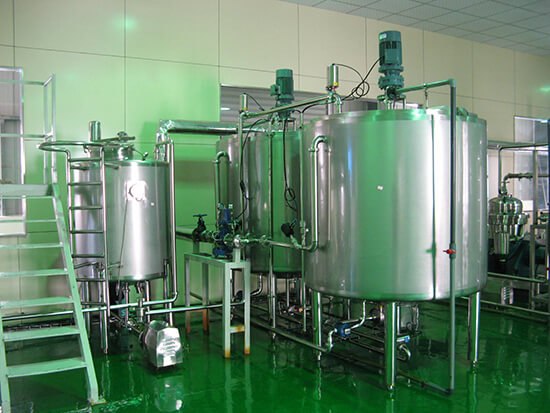
Energy drinks pasteurizer
Pump the uniformly prepared mixture liquid into the plate type pasteurizer or tubular UHT sterilizer for pasteurization/sterilization, and the sterilization conditions should be determined according to the composition of the material, some energy beverages can be heat-treated by 85-95°C pasteurization, and then hot-filled into small packages; Whereas some heat-sensitive drinks can use the UHT sterilizing, 135℃ for 3-5S.

Energy drinks filling machine
When filling functional or energy beverages, there are two types of filling machines to choose from. The first one is 85-89℃ hot filling. Because of the higher filling temperature, this type of filling process damage of vitamin and other healthcare materials in the beverage, which reduces the quality of the product; The second type is 65-75℃ medium-temperature filling. Because the filling temperature is low, there are strict sanitary requirements for the filling environment and packaging containers. The filling room needs to be air-purified, and the filling containers(bottles or cans) need to be rinsed with H2O2 disinfectant and sterile water before filling.

Functional Drinks Classification
Energy drink is one of the types of functional drinks, now we have classified functional drinks into the following type:
Sports Drinks: Sports drinks are drinks that replenish the electrolytes and energy lost by the body after exercise to restore the body’s physical fitness, mainly including electrolyte drinks and high-energy drinks. Electrolyte beverages will add enough inorganic salts (electrolytes) and vitamins during the production process. The total solid content is equal to the human body’s osmotic pressure. It can quickly replenish body fluids, various electrolytes and vitamins lost after exercise, prevent muscle fatigue and excessive pulse rate, maintains the vitality of blood cells and plays an important role in muscle contraction and blood coagulation. High-energy drink contains fructose, glucose and electrolytes, which are easily absorbed by the human body, it also contains vitamins necessary for the human body and herb ingredients to strengthen the body. In the production of sports drinks, the commonly used ingredients are pure water, fructose, glucose, vitamins, citric acid, potassium, calcium, sodium, magnesium and other electrolytes, food flavor and carbon dioxide. All these ingredients mixed evenly, then pasteurizing and filling into bottles or cans. Jianlibao is the most representative sports drink brand.
Energy Drinks: It is a soft drink with a juice flavor or no juice flavor that can provide energy. Most of the energy drinks are carbonated, but there are also non-aerated and powdered products. Products generally contain taurine, caffeine, guarana, glucose and plant extracts as well as minerals and vitamins. Energy drinks with caffeine and refreshing properties are originally produced in Japan and Thailand, and the global market is growing rapidly. Redbull and MONSTER drinks are the famous energy drinks in global.
Nutrient Drinks: Nutrient beverages refer to adding some vitamins and minerals needed by the human body to the beverages, which have similar effects to health care products, they have the function of anti-fatigue and boosting the human immune. You can add mushrooms, white fungus and other foods rich in polysaccharides, selenium, germanium. Some herbal ingredients such as turmeric, Lingzhi, Ginseng, prickly pear wolfberry, etc. can also be added, and finally mix with sweeteners, preservatives, flavors and fragrances to make the function Drink.
Other Functional Drinks: In addition to the main functional beverages mentioned above, there are also functional beverages added with dietary fiber, oligosaccharides (Bifidobacterium growth factor), active probiotic beverages and trace elements (Zn and Se). Dietary fiber beverages, such as soybean dietary fiber beverages, konjac edible dietary fiber beverages, and peel dietary fiber beverages. Beverages containing probiotics, such as yogurt drinks. Probiotics can promote lactose digestion and effectively alleviate lactose intolerance. In addition, probiotics can also slow down allergic reactions, reduce serum cholesterol levels through bacterial metabolism, regulate blood lipids, reduce the occurrence of cardiovascular diseases, and have obvious antioxidant effects .
